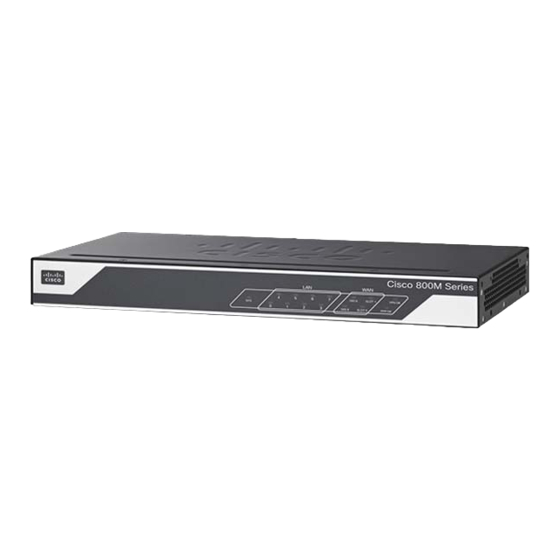
Cisco 800M Series Configuration Manual
Hide thumbs
Also See for 800M Series:
- Installation manual (44 pages) ,
- User manual (44 pages) ,
- Getting started manual (32 pages)
Table of Contents
Advertisement
Quick Links
Configuring the Serial Interface
This chapter describes configuring the serial interface for Cisco 800M Series ISRs in the following
sections:
•
•
•
•
•
Configuring the Serial Interface
The Cisco 800M Series Integrated Services Router (ISR) provides serial WAN connectivity to remote
sites using Cisco High-Level Data Link Control (HDLC), Point-to-Point Protocol (PPP), or Frame Relay
encapsulation through the pluggable, serial WAN interface module. The Cisco 800M Series ISR supports
both synchronous and asynchronous modes of communication.
Features Supported by Serial Module
The Cisco 800M Series ISR has 2 WAN slots that can host single-port serial module or multi-mode 3G
module and supports the following combinations.
•
•
•
The features supported by the single-port serial module on Cisco 800M Series ISR is given as follows:
•
•
Configuring the Serial Interface, page 39
Features Supported by Serial Module, page 39
Information About Configuring Serial Interfaces, page 41
How to Configure Serial Interfaces, page 45
Configuration Examples, page 47
Serial module in slot 0 and 3G module in slot 1
3G module in slot 0 and serial module in slot 1
Serial module in slot 0 and serial module in slot 1
Supports the following encapsulations :
HDLC
–
PPP
–
Frame Relay
–
Serial Line Internet Protocol (SLIP)
–
Supports the following serial protocols
Cisco 800M Series Integrated Services Routers Software Configuration Guide
4
C H A P T E R
39
Advertisement
Table of Contents

Summary of Contents for Cisco 800M Series
- Page 1 Features Supported by Serial Module The Cisco 800M Series ISR has 2 WAN slots that can host single-port serial module or multi-mode 3G module and supports the following combinations. Serial module in slot 0 and 3G module in slot 1 •...
- Page 2 Supports asynchronous speed of up to 115.2 kbps • Supports network clock synchronization • Cisco 800M Series ISRs use Cisco smart serial connectors. Information about the cables supported by Cisco 800M Series ISRs are provided in Table 4-1. Table 4-1...
-
Page 3: Information About Configuring Serial Interfaces
• Cisco HDLC Encapsulation Cisco High-Level Data Link Controller (HDLC) is the Cisco proprietary protocol for sending data over synchronous serial links. Cisco HDLC also provides a simple control protocol called Serial Line Address Resolution Protocol (SLARP) to maintain serial link keepalives. Cisco HDLC is the default for data encapsulation at Layer 2 (data link) of the Open System Interconnection (OSI) stack for efficient packet delineation and error control. - Page 4 IP Control Protocol (IPCP) to negotiate IP properties • Multiprotocol Label Switching control processor (MPLSCP) to negotiate MPLS properties • Cisco Discovery Protocol control processor (CDPCP) to negotiate CDP properties • • IPv6CP to negotiate IP Version 6 (IPv6) properties •...
-
Page 5: Keepalive Timer
• Keepalive Timer Cisco keepalives are useful for monitoring the link state. Periodic keepalives are sent to and received from the peer at a frequency determined by the value of the keepalive timer. If an acceptable keepalive response is not received from the peer, the link makes the transition to the down state. As soon as an acceptable keepalive response is obtained from the peer or if keepalives are disabled, the link makes the transition to the up state. -
Page 6: Frame Relay Encapsulation
ECHOREQ packets to its peer. To restore the system to the default keepalive interval of 10 seconds, use the keepalive command with the no keyword. To disable keepalives, use the keepalive disable command. For both PPP and Cisco HDLC, a keepalive of 0 disables keepalives and is reported in the show running-config command output as keepalive disable. -
Page 7: How To Configure Serial Interfaces
LMI on Frame Relay Interfaces The Local Management Interface (LMI) protocol monitors the addition, deletion, and status of PVCs. LMI also verifies the integrity of the link that forms a Frame Relay UNI interface. By default, cisco LMI is enabled on all PVCs. - Page 8 “Configuration Examples” section on page 4-47. Configuring Asynchronous Serial Interface You can use the physical-layer async command to change the interface mode from the default synchronous mode to asynchronous mode SUMMARY STEPS physical-layer async Cisco 800M Series Integrated Services Routers Software Configuration Guide...
-
Page 9: Configuration Examples
Router(config)# hostname R1 R1(config)# username R2 password cisco R1(config)# interface serial 0/0/0 R1(config-if)# encapsulation ppp R1(config-if)# ppp authentication PAP R1(config-if)# ppp pap sent-username R1 password cisco R1(config-if)# end Router> enable Router#configure terminal Cisco 800M Series Integrated Services Routers Software Configuration Guide... -
Page 10: Example: Frame Relay Configuration
Router1(config-if)# ppp multilink group 1 Router1(config-if)# end Router1(config)# interface Serial 0/2/1 Router1(config-if)# no ip address Router1(config-if)# encapsulation ppp Router1(config-if)# no ip route-cache Router1(config-if)# ppp multilink Router1(config-if)# ppp multilink group 1 Router1(config-if)# end Cisco 800M Series Integrated Services Routers Software Configuration Guide... -
Page 11: Example: Asynchronous Serial Configuration
Configuring Media-Independent PPP and Multilink PPP Serial Interface Configuration Interface and Hardware Component Configuration Guide, Cisco IOS Release 15M&T Frame Relay Wide-Area Networking Configuration Guide: Frame Relay, Cisco IOS Release 15M&T Cisco 800M Series Integrated Services Routers Software Configuration Guide... - Page 12 Chapter 4 Configuring the Serial Interface Related Documents Cisco 800M Series Integrated Services Routers Software Configuration Guide...











